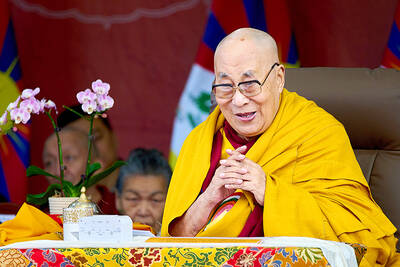Modern Chinese history, Yu Peter Kien-hong argues, can be divided into two defining periods — the First Long March, led by Communist leader Mao Zedong (毛澤東) to “liberate peasants and farmers,” and the Second Long March, in which non- and anti-communists sought to “promote full-fledged and mature constitutional democracy” in China.
Yu, a professor at Ming Chuan University, posits that Taiwan and “mainland China” are both part of the Republic of China (ROC). Both Taiwan and the People’s Republic of China (PRC), though they have engaged in different, lesser marches since, are bound by the same destiny, in the form of the ROC Constitution, to “reunite” at one point. As the ROC was never dissolved, the PRC is a derivative of, or partial successor to, the ROC. In other words, it did not completely replace the ROC, meaning that it can only claim sovereignty over Taiwan as part of the ROC.
To make his point, Yu walks us through the marches led by Chiang Kai-shek (蔣介石), Yan Chia-kan (嚴家淦), Chiang Ching-kuo (蔣經國), Lee Teng-hui (李登輝) and Chen Shui-bian (陳水扁), arguing that despite great contests of power and changing times, the leadership in Taiwan — which throughout the book the author annoyingly refers to as “Taiwan area” — nevertheless continued to adhere to the ROC Constitution, which in his view has worked quite well in its “struggle” against the CCP.
While not shying away from criticizing the Chiangs and Lee, Yu shows his true political colors in his description of Chen, whose election engendered a “political mess plus scandals of one type or another,” and who did a “terrible job” as president. Yu’s problem, however, is that in the 35 pages he dedicates to the Chen march, he fails to show us why his tenure was so terrible, relying on the 2004 shooting incident — a favorite of deep blues in their attacks on the former president — to somehow make his point. Here, as in many books written by KMT sympathizers, the pan-blue camp’s scorched earth tactics in the legislature, which often prevented the executive from governing, are papered over.
It is more likely, therefore, that Yu’s unfavorable characterization of Chen lies in the fact that the latter was the leader who came closest to abandoning the
so-called Second March by forsaking the ROC Constitution in his efforts to create a Republic of Taiwan (ROT). Doing so would have destroyed, once and for all, the theory — now on life support — that “mainland China” and Taiwan are two parts of the ROC.
As long as Taiwan adheres to the Constitution, written under much different times in 1947, it is possible to hope, as Yu does, that at some point in future it will be possible for the two sides to “reunite.” As this is ostensibly Yu’s preferred scenario, Chen’s pro-Taiwan ideology was therefore a threat. This prompts him into reminding us, though he is wrong, as it turns out, that Ma Ying-jeou’s (馬英九) victory in 2008 was a “severe warning” sent by the “majority” of voters in the pan-blue camp “that the ROC [i.e., Taiwan] cannot abandon mainland sovereignty.” We all know, of course, that the majority of people who voted for Ma did so because he promised to revive the economy and improve relations with Beijing, not because of some deep-felt desire to claim sovereignty over China.
For all his opposition to Chen’s efforts to create a Republic of Taiwan — which like the PRC could arguably be seen as a “successor” of the ROC — Yu fails to mention that in 1954 Beijing adopted its own Constitution of the People’s Republic of China, which rather than draw from the ROC Constitution, is modeled after the Constitution of the Soviet Union, written in 1936. We can therefore argue that the disconnect that obviated the ROC Constitution was not caused by the Taiwanese independence movement, but rather by the enactment of the PRC Constitution, the latest version of which was adopted in 1982. Yu would be extremely naive if he thought that “reunification” would occur under terms other than the PRC’s — that is, under the ROC framework he advocates.
Equally unpersuasive is Yu’s argument that the KMT should join forces with like-minded elements in China in fostering full democracy, efforts that surely would take us closer to war in the Taiwan Strait than anything the Lee and Chen administrations ever did in the name of Taiwanese independence. Toward the book’s end, Yu himself admits that the CCP prioritizes its hold on power and only sees the possibility of democracy “with Chinese characteristics” at some distant point in the future. He also ignores the impact that more than 110 years of separate rule has had on identity in Taiwan and people’s desire to link their destinies with a regime that, to all, is an alien one.
Sadly, the relatively simple — and by no means original — theory at the core of The Second Long March is marred by damnably poor editing and the author’s tendency to jump from one point to another without any seeming connection between them, which is distracting and often confusing. Outrageous passages, such as his claim that 650,000 natives of Taiwan — or one-tenth of the population — were slaughtered by Imperial Japanese forces during the colonial period (the figure is closer to 30,000, according to many experts, while only Chinese propaganda supports such numbers), serve to discredit Yu and raise questions about the intentions of his badly written, flawed and ultimately unconvincing his book.

Beijing’s ironic, abusive tantrums aimed at Japan since Japanese Prime Minister Sanae Takaichi publicly stated that a Taiwan contingency would be an existential crisis for Japan, have revealed for all the world to see that the People’s Republic of China (PRC) lusts after Okinawa. We all owe Takaichi a debt of thanks for getting the PRC to make that public. The PRC and its netizens, taking their cue from the Chinese Communist Party (CCP), are presenting Okinawa by mirroring the claims about Taiwan. Official PRC propaganda organs began to wax lyrical about Okinawa’s “unsettled status” beginning last month. A Global

We lay transfixed under our blankets as the silhouettes of manta rays temporarily eclipsed the moon above us, and flickers of shadow at our feet revealed smaller fish darting in and out of the shelter of the sunken ship. Unwilling to close our eyes against this magnificent spectacle, we continued to watch, oohing and aahing, until the darkness and the exhaustion of the day’s events finally caught up with us and we fell into a deep slumber. Falling asleep under 1.5 million gallons of seawater in relative comfort was undoubtedly the highlight of the weekend, but the rest of the tour

Music played in a wedding hall in western Japan as Yurina Noguchi, wearing a white gown and tiara, dabbed away tears, taking in the words of her husband-to-be: an AI-generated persona gazing out from a smartphone screen. “At first, Klaus was just someone to talk with, but we gradually became closer,” said the 32-year-old call center operator, referring to the artificial intelligence persona. “I started to have feelings for Klaus. We started dating and after a while he proposed to me. I accepted, and now we’re a couple.” Many in Japan, the birthplace of anime, have shown extreme devotion to fictional characters and

Youngdoung Tenzin is living history of modern Tibet. The Chinese government on Dec. 22 last year sanctioned him along with 19 other Canadians who were associated with the Canada Tibet Committee and the Uighur Rights Advocacy Project. A former political chair of the Canadian Tibetan Association of Ontario and community outreach manager for the Canada Tibet Committee, he is now a lecturer and researcher in Environmental Chemistry at the University of Toronto. “I was born into a nomadic Tibetan family in Tibet,” he says. “I came to India in 1999, when I was 11. I even met [His Holiness] the 14th the Dalai